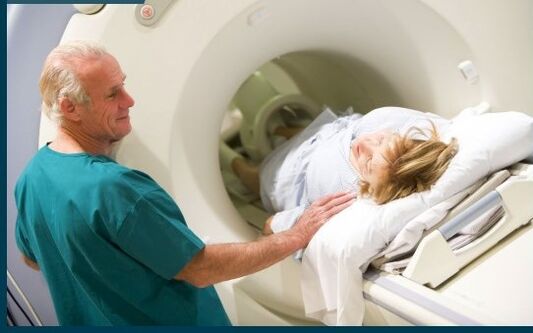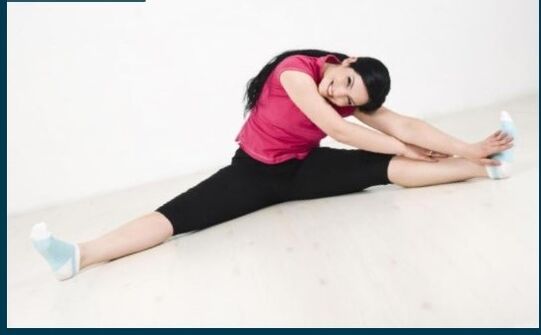The spine is osteochondrosis is a degenerative-dynish pathology characterized by damage to joint surfaces, discs between the vertebrae, and muscle ligagens.The disease has a chronic path and has serious consequences.
The therapeutic effect of osteochondrosis is complex.It is important to diagnose the disease in time - the sooner the treatment begins, the greater the probability of a positive result.It is almost impossible to reverse the degenerative processes, but you can stop them in the debut phase.Progressive osteochondrosis can lead to protrusions, intervertebral disks hernia, and neurological pathologies.
General information about the disease
Osteocondrosis is the most common spinal disease and one of the most commonly diagnosed human pathologies.The disease can be considered as a specific calculation of the benefits of uprising and civilization.Animals do not have osteochondrosis because their spinal column is horizontally.
If you have periodic or regular back pain, these are manifestations of osteochondrosis in 75-80%.
In the chest region, degenerative changes occur less frequently than in the back specialist and cervix.Usually the chest region occurs after 40 years.The predisposing factors are both excessive load on the spine and a sedentary lifestyle.In the latter case, blood circulation of cartilage and bone structures and bone structures are disturbed, leading to gradual dystrophy.
In recent decades, doctors have noted the widespread "rejuvenation" of the disease.Osteocondrosis is diagnosed even in people aged 25-30, which involves the change in the planet's environmental status, the nature of nutrition and the lifestyle of modern people.Your own car, office work, preference for passive relaxation on your computer is active-these are not contributing to the health of the muscle bone system.
The risk of breast (and any other) osteochondrosis is that it is almost impossible to restore the tissues of the intervertebral discs: this means that the segments affected by dystrophic and degenerative transformations are slow, but doomed to impossible destruction.The task of treating osteochondrosis is to stop the destruction of hard and soft tissues and to minimize the risk of complications.
Characteristics of chest osteochondrosis
The chest zone osteochondrosis negatively affects the human ability of active movement.The progression of the disease is also filled with lace of the nerve endings of the spinal cord, which inevitably affects the functional state of the internal organs.The breast osteochondrosis causes heart function and breathing problems in its advanced clinical situations.
The chest region is distinguished by low mobility;The load on it is not as high as the neck and the lower back.Anatomically breast germinations are connected to the ribs and sternum and are combined and strongly designed, protected from injuries and external influences.Therefore, the breast osteochondrosis rarely manifests itself in the initial stages.The same circumstance determines the relative rarity of the diagnosis of "breast osteochondrosis".
The provocative factors of the disease are usually injuries, posture violations, skoliosis and other anatomical disorders.Signs of osteochondrosis of the chest region are quite late, usually during the stages of compression of nerve roots.
How can the chest osteochondrosis manifest
The first manifestation of the disease is pain between blades.The pain increases at the cargo, or vice versa, after a long stay in the morning in the morning.Pain often passes along the intercostal nerve and runs quickly when sneezing, coughing.

Heart pains are possible, compared to the attack of angina pectoris and the manifestation of heart failure.Symptoms and similarity of heart disease often lead to misdiagnosis.Symptoms are sometimes similar to signs of inflammation of the bladder, ulcer or gastritis.A complete clinical diagnosis should be made to identify the true cause of pain.
Other signs of chest osteochondrosis, along with pain:
- Neurological symptoms - feeling of "goosebams" on the skin and abdomen;
- Numbness of skin areas, impaired sensitivity;
- Heart violation, pelvic organs (with the development of spinal compression);
- Intercostal neuralgia - pain in the ribs, transition to sternum (develops in the form of seizures and generally provokes weights, hypothermia, stress);
- Dorsalgia - the stiffness of the case muscles and the pain during inhalation/exhalation;
- Reflex muscle tension (the body tries to reduce the symptoms of pain due to physiological immobilization of the affected spine).
The longer the disease lasts, the more it expressed its signs.It is important not to try to eliminate them with analgesics and other drugs, but to determine by clinical methods.At best, the meditation of osteochondrosis alone is meaningless and, at worst, dangerous and complicated.
The causes of pathology
Doctors did not fully investigate mechanisms that trigger the process of tissue degeneration.It is assumed that osteochondrosis on the vertebrae causes the back muscle coating to distribute inadequate loads.The circumstances that increase the likelihood of the disease have been clarified in detail.
The main factors of influencing:
- Hypodynamia (sedentary work, tendency to rest);
- Excessive load due to the birth of activity;
- Spine damage;
- Overweight;
- Heredity;
- Irrational nutrition;
- Curvature of the spine;
- Violation of posture, satisfying labor hygiene;
- Metabolic pathologies;
- Age -related dysphropic processes in tissues;
- Exposure to constant vibration (for example, when working with a hammer connector);
- Flat foot;
- Walking in a high bar;
- Voltage;
- Infectious diseases.
Disease athletes, movers, truck drivers, builders and office workers.Most often the disease is multifactoral - a combination of many internal and external factors leads to its development.
The widespread opinion that osteochondrosis is formed because of the "salts deposits" is scientifically incorrect.The calcification of plates and cartilage is indeed done with degenerative diseases of the spine, but this is not the result of the trigger, but the consequence of pathology.
Diagnostic methods
Identification of the disease begins by studying the patient's initial examination, symptoms, the patient's lifestyle, studying information about the nature of nutrition and concomitant diseases.The affected areas are palpated.

The following diagnostic procedures are prescribed:
- General clinical examination of blood and urine;
- Radiography;
- Ultrasound, MRI and CT;
- Myelography - Introduction of contrast with the spinal cord to study its structure.
The most reasonable diagnostic method is X -try.Generally, targeted radiography of specific spinal segments is usually performed.The images allow the identification of the atrophy of the discs (reducing their thickness), the presence of osteophytes - the growth of bones and the shape of the spine.
Consultations of other pathologies with similar symptoms may require consultations of cardiologists, gastroenterologists and other professionals (and relevant examinations - ECG, gastroscopy).The main treatment is performed by an orthopedic or a spinal doctor - a spinal specialist.
Modern methods of the therapy of chest osteochondrosis
The therapeutic effect begins with the detection of the cause of the disease.If this is an infection, antibiotic treatment is performed if the muscle device is weak to confirm it.More often, treatment is outpatient, except for situations with heavy clinic.
The main purpose of treatment is to minimize degenerative processes and their consequences.Each case requires the production of individual treatment regimens, including drug effects, physiotherapy methods and further rehabilitation methods.They primarily practice conservative therapy and practice less frequently prescribed surgery.
Experienced doctors will never treat treatment based on isolated methodology or mere drug effects.Treatment of spinal diseases with tablets that eliminate the symptoms of pain, without therapeutic perspective, and a sign of unprofessional approach.At the same time, it is impossible to fully do without medication - especially at the acute stage of the disease.
Drug treatment
Apply the following groups of drugs:
- Painkillers;
- Anti -inflammatory drugs;
- Steroids;
- Musorelaxants to relieve cramps;
- Vitamins.
The preparations are used primarily in the initial stages of treatment.They stop acute pain, eliminate inflammation (if any), stimulate metabolism processes.More often, drugs are used externally (in the form of ointments), less often in the form of tablets.Even less frequently, an injection should be made in the affected area - this method is called "novocaine blockade".
Physiotherapy
Physiotherapeutic methods get the leading role in the degenerative pathology of the chest back.These methods eliminate pain, inflammation, and restore the nutrition of affected tissues.Hardware and other methods of exposure are used:
- Laser treatment;
- Magnetic therapy;
- Amplipulstherapy;
- Exposure to ultrasound;
- Balneotherapy (treatment with water);
- Paraffin therapy;
- Mud;
- Hypothermia - cold therapy;
- Electrophoresis and phonophoresis.
The advantage of physiotherapy in absolute safety.For health reasons, this method has no contraindication.The competent use of physical techniques also provides a healing effect in the most difficult cases.
Independent physiotherapy method - reflex treatment: Effect on body acupuncture.The most famous way of reflexology is acupuncture.Cauterization is also done, acupressure.It has been proven that a competent effect on some zones launches suicide mechanisms and eliminates pain.
Therapeutic gymnastics
Body practice therapy is a method used to treat osteochondrosis and to prevent complications.The complex of physical exercises is selected separately.The purpose of physical treatment is to reduce pressure on the nerve root, to strengthen ligaments and muscles, and prevent protrusions and hernia.

Tournament complexes or qualified instructor should be performed in accordance with the safety rules.Dangerous muscles overload, so exercises should be accompanied by rest periods.
Manual therapy
Massage of osteochondrosis has the same purpose as physiotherapy and exercise therapy pain relief, improves the functionality of the league and muscle device and stimulates blood circulation.Professional competent massage seizes the nutrition of soft tissues and cartilage and accelerates regeneration processes.Mechanical devices - the use of applicants, electrical and roller massagers is allowed.
A separate type of manual therapy is osteopathy.The method includes a specialist in diagnostic and therapeutic manipulations.Such a massage is distinguished by softness and physiological.Osteopathy eliminates tissue damage and there is no restriction of age.
Diet
The main principles of osteochondrosis diet therapy are equilibrium: all necessary trace elements, presence of vitamins, reduced number of calories.Another important criterion in the product menu of the cartilage tissue synthesis is in the body.These compounds are called mucopolysaccharides: most of these substances are contained in jerks, gels and floods.
Radical therapy
In modern clinics, the breast osteochondrosis surgery surgery is extremely rare.Operations can only be required if the complications occur in the form of persistent radicular syndrome.The intervention can be assigned to protruding protrusions and hernia.
Prevention
It is much easier to prevent the disease than long -term, sometimes long -term therapy.Prevention of osteochondrosis should be performed from childhood.It hinders degenerative processes: proper posture, spinal load, compliance with sport safety, rational nutrition, sleeping on the maximum flat surface.It is important to detect the first signs of the disease in time and to strictly implement your doctor's recommendations.



















